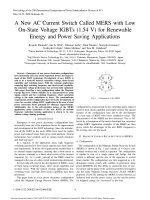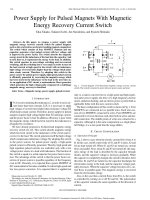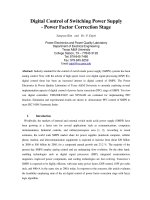A digitally controlled switch mode power supply based on matrix converter
Bạn đang xem bản rút gọn của tài liệu. Xem và tải ngay bản đầy đủ của tài liệu tại đây (1.03 MB, 7 trang )
124 IEEE TRANSACTIONS ON POWER ELECTRONICS, VOL. 21, NO. 1, JANUARY 2006
A Digitally Controlled Switch Mode Power
Supply Based on Matrix Converter
Somnida Ratanapanachote, Han Ju Cha, and Prasad N. Enjeti, Fellow, IEEE
Abstract—High power telecommunication power supply systems
consist of a three-phase switch mode rectifier followed by a dc/dc
converter to supply loads at
48 V dc. These rectifiers draw sig-
nificant harmonic currents from the utility, resulting in poor input
power factor with high total harmonic distortion (THD). In this
paper, a digitally controlled three-phase switch mode power supply
based on a matrix converter is proposed for telecommunication ap-
plications. In the proposed approach, the matrix converter directly
converts the low frequency (50/60 Hz, three-phase) input to a high
frequency (10/20 kHz, one-phase) ac output without a dc-link. The
output of the matrix converter is then processed via a high fre-
quency isolation transformer to produce
48 V dc. Digital con-
trol of the system ensures that the output voltage is regulated and
the input currents are of high quality under varying load condi-
tions. Due to the absence of dc-link electrolytic capacitors, power
density of the proposed rectifier is expected to be higher. Anal-
ysis, design example and experimental results are presented from
a three-phase 208-V, 1.5-kW laboratory prototype converter.
Index Terms—Three-phase switch mode rectifier, total harmonic
distortion (THD).
I. INTRODUCTION
M
ODERN telecommunication power systems require
several rectifiers in parallel to obtain higher current
dc output at
48 V dc [1]–[4]. Commercially available
telecom-rectifiers [1] employ ac to dc conversion stage with a
boost converter, followed by a high frequency dc/dc converter
to produce
48 V dc (see Fig. 1). This type of rectifier draws
significant fifth and seventh harmonic currents resulting in
near 40% total harmonic distortion (THD). In addition, the
rectifier dc-link capacitor stage is bulky, contributes to weight
and volume. Furthermore, the presence of multiple power
conversion stages contributes to lower efficiency.
In response to these concerns, this paper proposes a digitally
controlled switch mode power supply based on a matrix con-
verter for telecommunication applications (Fig. 2). Matrix con-
verter topology employs six bidirectional switches to convert
lower frequency (50/60 Hz) three-phase input directly to a high
frequency (10/20 kHz) one-phase output. The output is then
processed via an isolation transformer and rectified to
48 V
Manuscript received April 28, 2004; revised June 29, 2005. Recommended
by Associate Editor J. R. Rodriguez.
S. Ratanapanachote is with the Department of Electrical Engi-
neering, Mahidol University, Nakhon Pathom 73170, Thailand (e-mail:
).
H. J. Cha is with the Department of Electrical Engineering, Chungnam Na-
tional University, Daejeon 305-764, Korea (e-mail: ).
P. N. Enjeti is with the Department of Electrical Engineering, Texas A&M
University, College Station, TX 77843 USA (e-mail: ).
Digital Object Identifier 10.1109/TPEL.2005.861197
dc. Digital control of the matrix converter stage ensures that
the output voltage is regulated against load changes as well as
input supply variations while maintaining sinusoidal input cur-
rent shape at near unity power factor.
Advantages of the proposed topology are:
•
no dc-link capacitor required;
•
capable of operation over a wide input voltage range;
•
low total harmonic distortion (THD) in line current;
•
proper switching modulation results in smaller input filter;
•
unity input power factor over a wide load range;
•
higher efficiency with increased power density;
•
digital control facilitates external communication; enable
parallel operation of several stages and implementation of
complex closed loop control functions.
The paper present a detailed analysis of the modulation
scheme, discusses a design example and experimental results
on a three-phase 208-V, 1.5-kW laboratory prototype converter.
II. P
ROPOSED SWITCH MODE
POWER SUPPLY
The proposed digitally controlled switch mode power supply
based on matrix converter is shown in Fig. 2. Matrix converter
topology employs six bidirectional switches to convert lower
frequency (50/60 Hz) three-phase input directly to a high fre-
quency (10/20 kHz) one-phase output. The output is then pro-
cessed via an isolation transformer and rectified to
48 V dc.
Digital control of the matrix converter stage ensures that the
output voltage is regulated against load changes as well as input
supply variations.
Matrix converter is a direct ac/ac converter and operates
without a dc-link [5]. It has the advantage of bidirectional
power flow, controllable input power factor, high reliability,
and compact design. High operating frequency of the system
allows the size and weight of the transformer to be reduced.
In this paper, space vector modulation technique applied to a
matrix converter is employed. For hardware implementation, a
three-phase to three-phase matrix converter module based on
1200-V IGBT introduced by EUPEC [6] is used.
III. M
ATRIX
CONVERTER PWM MODULATION
In the proposed topology a three-phase to one-phase ma-
trix converter (Fig. 3) employing twelve IGBT switches is
employed.
The PWM modulation is divided to two modes, rectifier mode
and inverter mode, respectively. Fig. 4 illustrates the modula-
tion modes of matrix converter as traditional ac/dc/ac conver-
sion system. Due to the absence of dc-link,
is presented as
a fictitious dc voltage for analysis purposes.
0885-8993/$20.00 © 2006 IEEE
RATANAPANACHOTE et al.: DIGITALLY CONTROLLED SWITCH MODE POWER SUPPLY 125
Fig. 1. Conventional telecommunication switch mode power supply [1].
Fig. 2. Proposed digitally controlled switch mode power supply based on matrix converter.
Fig. 3. Figure of three-phase to one-phase matrix converter.
Fig. 4. Illustration of matrix converter operation.
The operation of the matrix converter can be expressed math-
ematically in a matrix formation. The fictitious dc voltage,
,
is derived from the rectifier mode of operation
(1)
where
is rectifier mode transfer function and is the input
voltage vector. Matrix converter output voltage,
, is derived
from the inverter mode of operation as
(2)
where
is the inverter mode transfer function. The line cur-
rent
can be expressed in terms of rectifier and inverter mode
transfer functions as
(3)
The three-phase input voltage vector
is given by
(4)
where
is amplitude of input voltage and is input angular
frequency.
A. Rectifier Mode of Operation
As detailed in the earlier section, matrix converter analysis is
simplified by separating the rectifier and inverter mode of op-
erations. The objective of the rectifier mode of operation is to
126 IEEE TRANSACTIONS ON POWER ELECTRONICS, VOL. 21, NO. 1, JANUARY 2006
Fig. 5. Rectifier space vector hexagon.
create a fictitious dc voltage from input voltage and to main-
tain unity input power factor. Rectifier space vector hexagon is
shown in Fig. 5.
The switching vectors in the hexagon in Fig. 5 are indicated
by the switches from rectifier part in Fig. 4. The placement of
space vector reference vector,
, within one sector is defined
by adjacent the switching vectors,
and . The angle is
angle of space vector reference vector. The duty cycles of the
active switching vectors are calculated with rectifier mode mod-
ulation index,
(5)
(6)
(7)
Rectifier mode matrix,
, can be set up from switching func-
tions S1 to S6 established by space vector method. Number of
elements in
depends on the number of input phases
(8)
(9)
(10)
(11)
It can be stated that
and are the same function as
with phase shifting of 2 3 and 2 3, respectively. From
(1) and (4), the fictitious dc voltage
1.5 (12)
B. Inverter Mode of Operation
The objective of this mode of operation is to generate a high
frequency single phase output voltage. The operating frequency
in this mode is the same as desired output frequency.
From the rectifier mode, fictitious dc voltage,
, is found.
It is used as the input of single phase inverter part in Fig. 2. Due
to only one phase for the matrix converter output, the inverter
mode matrix,
, has single element
(13)
(14)
The switching function,
, can be generated as shown in
Fig. 6. The control signal,
, is varied to obtain desired ma-
Fig. 6. Inverter mode switching function.
trix converter output voltage. The switching function can be ex-
pressed as
(15)
(16)
From (2) and (12) and let
be inverter mode modulation
index
(17)
C. Proposed PWM Switching Modulation
From (1) and (2), it can be shown that matrix converter output
can be found from
(18)
Equation (18), the transfer function,
, is representing the
matrix converter switching function. Thus, switching function
of matrix converter switches can be realized as follows.
From (8)–(11), (13), and (14) we have
(19)
(20)
Block diagram of the proposed matrix converter modulation
is shown in Fig. 7. Each switch can be implemented with the
logic gates as shown in Fig. 8.
RATANAPANACHOTE et al.: DIGITALLY CONTROLLED SWITCH MODE POWER SUPPLY 127
Fig. 7. Block diagram of the proposed matrix converter modulation.
Fig. 8. Matrix converter switch gating signals generating through logic gates.
IV. A
NALYSIS OF THE PROPOSED POWER CONVERSION
STAGE
A. Voltage Analysis
In the proposed topology, input source voltage is converted to
high frequency voltage through operation of three-phase to one-
phase matrix converter. From (1) and (2), the matrix converter
output voltage is given by
(21)
From (4), (8), and (13) we have
(22)
where
(23)
(24)
(25)
Then
(26)
Equation (26) shows no dc component in the matrix converter
output voltage. The high frequency ac output voltage is con-
nected to isolation transformer stage.
In order to generate
48 V dc, the high frequency transformer
performs step-down operation with suitable turn ratio,
. The
selected
depends on value of input voltage and range of ma-
trix converter modulation index and is detailed in the design ex-
ample section.
B. Line Current and Harmonics Analysis
In this section the input line current is analyzed. Equation (3)
shows the input current
as a function of and the rectifier/in-
verter mode transfer functions. Now assuming the output cur-
rent
to be sinusoidal
(27)
where
is amplitude of output current and is output angular
frequency. The input current can be expressed as
(28)
From (28), line current
can be expressed as
(29)
128 IEEE TRANSACTIONS ON POWER ELECTRONICS, VOL. 21, NO. 1, JANUARY 2006
Substitute (14) and (24)–(29) yields
(30)
where
is the input frequency in rad/s ( 2 ,
60 Hz) and is the output frequency in rad/s ( 2 ,
10 kHz). Substituting and in (30), it is clear that the input
current does not have any low frequency harmonic components
and is of high quality. The high frequency components in
are
to be filtered by the input put filter stage of the converter.
V. D
ESIGN EXAMPLE
In this section, a design example is presented for the fol-
lowing input/output specifications.
To facilitate calculation in per-unit, the following base quan-
tities are defined
1.5 kW
48 V
31.25 A
1.536
Input line voltage 4.33 per unit.
The matrix converter output current
is given by
(31)
where
is the transformer turn ratio.
Select
4, 0.25 per unit.
Neglecting losses, the utility line current can be expressed as
(32)
And the input current
0.133 per-unit.
A. Input Filter Design
High frequency current components in the input current of
matrix converter can be filtered via a
filter. The value of
filter capacitor is selected by the following equation [7]:
(33)
where
is the power rating, is the peak of input voltage,
and
is angular input frequency.
Fig. 9. High frequency output voltage of the matrix converter.
Fig. 10. Output dc voltage (48 V).
Fig. 11. Input line to neutral input voltage and input current .
Fig. 12. THD percentage at different loads.
RATANAPANACHOTE et al.: DIGITALLY CONTROLLED SWITCH MODE POWER SUPPLY 129
Fig. 13. Proposed matrix converter prototype.
Fig. 14. Input voltage , matrix converter output voltage , and
transformer secondary voltage
. (1: [250 V/div], 2: [500 V/div],
3:
[100 V/div]).
The value of filter inductor is chosen by
(34)
where
is the cut-off frequency and is chosen to be lower than
the switching frequency (10 kHz). With the parameter values
given in this design example, and cut-off frequency is chosen to
be 1.7 kHz:
filter capacitance
60 F;
filter inductor
150 H.
VI. S
IMULATION RESULTS
In this section, simulation results of the proposed approach
are discussed. Fig. 9 shows the high frequency output voltage of
the matrix converter. Fig. 10 shows the 48-V dc output voltage.
Fig. 11 illustrates the performance of the proposed converter
from utility perspective. It is clear for these results that input
current is of high quality and is in phase with the input line
to neutral voltage. Fig. 12 shows the variation of input current
THD as a function of load.
Fig. 15. Transformer primary
and secondary voltages . (1:
[250 V/div], 3: [50 V/div]).
Fig. 16. Output dc voltage
and load current . (3: [50 V/div], 4:
[10 A/div]).
Fig. 17. Input line to neutral voltage and the input line current at
1.5 kW of output power. (2:
[5 A/div], 4: [125 V/div]).
130 IEEE TRANSACTIONS ON POWER ELECTRONICS, VOL. 21, NO. 1, JANUARY 2006
TABLE I
D
ESIGN SPECIFICATIONS OF THE
PROPOSED APPROACH
VII. EXPERIMENTAL
RESULTS
A laboratory prototype of the proposed digitally controlled
switch mode power supply was constructed to meet the spec-
ifications detailed in Section V. A commercially available ma-
trix converter module: FM35R12KE3 from EUPEC [6] was em-
ployed. A digital signal processor (TMS320LF2407) was used
for generating PWM gating signals and performing closed loop
functions. Fig. 13 shows the prototype matrix converter unit.
The unit is connected to bridge rectifier, which consists of four
fast-recovery diodes (60EPU02), and an output filter to produce
power supply voltage of 48 V dc.
Fig. 14 shows the input voltage
, matrix converter output
voltage (high frequency)
(connected to the transformer
primary winding) and the transformer secondary voltage
.
Fig. 15 shows the transformer primary and secondary voltages
with expanded time scale. Fig. 16 shows the output dc voltage
(48 V) and the load current. Fig. 17 shows the line to neutral
voltage
and the line current at 1.5-kW output power. It
is clear that the input current is of high quality and unity power
factor (see Table I) [8], [9].
VIII. C
ONCLUSION
In this paper, a digitally controlled switch mode power supply
based on matrix converter for telecommunication applications
has been shown. The proposed space vector PWM method has
been shown to yield high quality input current for varying load
conditions. Experimental results on a 1.5-kW prototype have
demonstrated the feasibility of a direct ac to ac matrix converter
in telecommunication power supplies.
R
EFERENCES
[1] Tyco Electronics, “Galaxy Switchingmode Rectifier 595 Series,” Tech.
Rep., Feb. 2003.
[2] A. I. Pressman, Switching Power Supply Design. New York: McGraw-
Hill, 1997.
[3] R. Redl and A. S. Kislovski, “Telecom power supplies and power
quality,” Proc. INTELEC’95, pp. 13–21, Nov. 1995.
[4] P. Enjeti and S. Kim, “A new dc-side active filter for inverter power
supplies compensates for unbalanced and nonlinear load,” in Proc. IEEE
IAS Annu. Meeting, Sep. 28–Oct. 4 1991, pp. 1023–1031.
[5] M. Venturini, “A new sine wave in, sine wave out, conversion tech-
nique eliminates reactive element,” in Proc. POWERCON 7, 1980, pp.
E3-1–E3-15.
[6] M. Hornkamp, M. Loddenkötter, M. Münzer, O. Simon, and M. Bruck-
mann, “EconoMAC the first all-in-one IGBT module for matrix con-
verters,” in Proc. EUPEC, 2005, [Online] Available: www.eupec.com.
[7] C. L. Neft and C. D. Schauder, “Theory and design of 30-hp matrix
converter,” IEEE Trans. Ind. Appl., vol. 28, no. 3, pp. 546–551, May/Jun.
1992.
[8] M. Kang, P. N. Enjeti, and I. J. Pitel, “Analysis and design of electronic
transformers for electric power distribution system,” IEEE Trans. Power
Electron., vol. 14, no. 6, pp. 1133–1141, Nov. 1999.
[9] H. Cha and P. N. Enjeti, “A three-phase AC/AC high-frequency link
matrix converter for VSCF applications,” in Proc. PESC’03, vol. 4, Jun.
2003, pp. 1971–1976.
Somnida Ratanapanachote received the B.Eng.
degree from Mahidol University, Nakhon Pathom,
Thailand, in 1995, and the M.Eng. and Ph.D. degrees
from Texas A&M University, College Station,
in 1998 and 2004, respectively, all in electrical
engineering.
In 1995, she received a full scholarship from
the Thai government and joined the Department of
Electrical Engineering, Mahidol University. In 2004,
she became a Lecturer at Mahidol University. Her
research interests include ac/ac power converter,
switch mode power supply, power quality, and power electronic applications.
Han Ju Cha received the B.S. degree in electrical
engineering from Seoul National University, Seoul,
Korea, in 1988, the M.S. degree from Pohang Insti-
tute of Science and Technology, Pohang, Korea, in
1990, and the Ph.D. degree from Texas A&M Uni-
versity, College Station in 2004, all in electrical en-
gineering.
From 1990 to 2001, he was with LG Industrial
Systems, Anyang, Korea, where he was engaged in
the development of power electronics and adjustable
speed drives. In 2005, he joined the Department of
Elecrical Engineering, Chungnam National University, Daejeon, Korea. His
research interests are high power converter, ac/dc, dc/ac and ac/ac converter
topologies, power quality and utility interface issues for distributed energy
systems, and advanced converters for information display.
Prasad N. Enjeti (M’85–SM’88–F’00) received the
B.E. degree from Osmania University, Hyderabad,
India, in 1980, the M.Tech degree from the Indian
Institute of Technology, Kanpur, in 1982, and the
Ph.D. degree from Concordia University, Montreal,
QC, Canada, in 1988, all in electrical engineering.
In 1988, he joined, as an Assistant Professor, the
Department of Electrical Engineering Department,
Texas A&M University, College Station. In 1994,
he was promoted to Associate Professor and in 1998
he became a Full Professor. He holds four U.S.
patents and has licensed two new technologies to the industry so far. He is the
lead developer of the Power Electronics/Power Quality and Fuel Cell Power
Conditioning Laboratories, Texas A&M University and is actively involved
in many projects with industries while engaged in teaching, research and
consulting in the area of power electronics, motor drives, power quality, and
clean power utility interface issues. His primary research interests are advance
converters for power supplies and motor drives; power quality issues and active
power filter development; converters for fuel cells, microturbine, wind energy
systems, power electronic hardware for flywheel, ultracapacitor type energy
storage/discharge devices for ride-through and utility interface issues.
Dr. Enjeti received the IEEE-IAS Second and Third Best Paper Award in
1993, 1998, 1999, 2001, and 1996, respectively; the Second Best IEEE-IA
T
RANSACTIONS
paper published in mid-year 1994 to mid-year 1995, the
IEEE-IAS Magazine Prize Article Award in 1996, the Class of 2001 Texas
A&M University Faculty Fellow Award for demonstrated achievement of
excellence in research, scholarship and leadership in the field, and he directed a
team of students to design and build a low cost fuel cell inverter for residential
applications, which won the 2001 future energy challenge award, grand prize,
from the Department of Energy (DOE). He is a Registered Professional
Engineer in the state of Texas.









